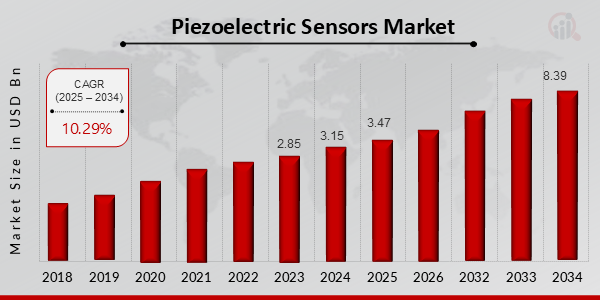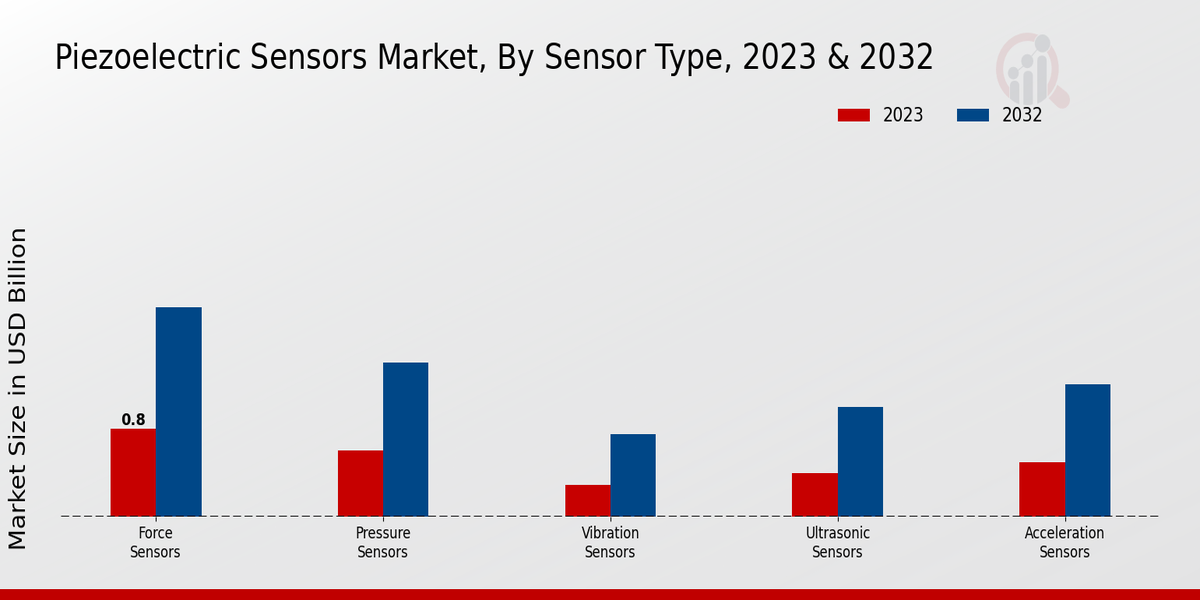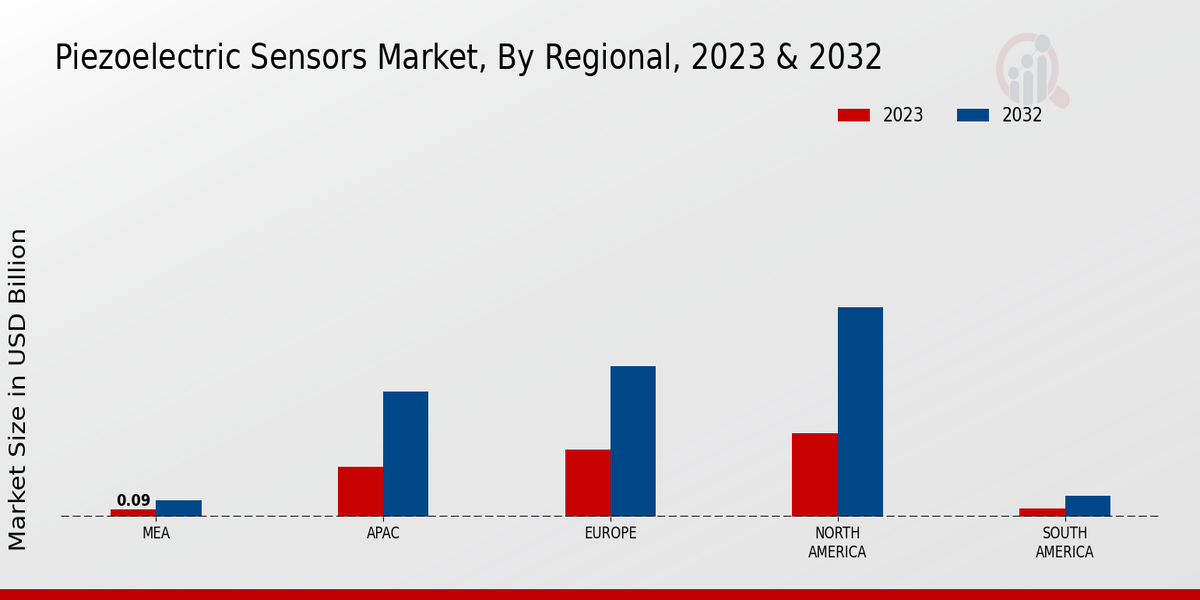Piezoelectric Sensors Market Overview
Piezoelectric Sensors Market is projected to grow from USD 3.47 Billion in 2025 to USD 8.39 Billion by 2034, exhibiting a compound annual growth rate (CAGR) of 10.29% during the forecast period (2025 - 2034).
Additionally, the market size for Piezoelectric Sensors Market was valued at USD 3.15 billion in 2024.
Key Piezoelectric Sensors Market Trends Highlighted
The Piezoelectric Sensors Market is driven by a growing demand for advanced sensing technologies across various sectors, including automotive, consumer electronics, healthcare, and industrial applications. The rising need for highly efficient and precise measurements in automation and control systems has significantly boosted the adoption of piezoelectric sensors. Additionally, the increasing focus on renewable energy and energy harvesting technologies is propelling the market, as these sensors play a crucial role in enhancing the performance and sustainability of energy systems.
The miniaturization of electronic components and the continuous innovations in sensor technology also serve as key market drivers, making piezoelectric sensors more versatile and applicable to a wider range of devices.With the rapid technological advancements and industry shifts, there are abundant opportunities to be explored within the piezoelectric sensors market. The integration of the Internet of Things (IoT) and smart technologies presents a significant chance for manufacturers to develop innovative solutions that cater to the growing demand for connectivity and real-time data analytics.
Furthermore, the expansion of the automotive and aerospace industries creates new avenues for piezoelectric sensors in safety-critical applications, where precision and reliability are paramount.In recent times, the trend towards the adoption of smart materials and self-sensing technologies has gained momentum. This trend signifies a move towards more functional materials that can monitor their own condition and performance, further enhancing the efficiency of systems in which they are employed. The growth in smart home applications is also a noteworthy trend, as consumers increasingly opt for devices that prioritize user experience and energy efficiency. Such trends not only reflect technological advancements but also underscore the evolving market landscape that piezoelectric sensors are poised to capitalize on effectively.
Figure 1: Piezoelectric Sensors Market size 2025-2034

Source: Primary Research, Secondary Research, MRFR Database and Analyst Review
Piezoelectric Sensors Market Drivers
Growing Demand for Smart Devices
The Piezoelectric Sensors Market industry is experiencing a significant surge in demand driven by the rapid advancement of smart technologies. The proliferation of smart devices, such as smartphones, wearable technology, and smart home appliances, has led to an increased need for efficient and precise sensors that can effectively monitor various parameters like pressure, acceleration, and strain. Piezoelectric sensors have gained prominence due to their outstanding responsiveness, accuracy, and ability to convert mechanical energy into electrical energy, making them an ideal choice for innovative applications in smart devices.As consumers continue to demand more sophisticated technology, global manufacturers are investing in the development of new piezoelectric sensor technologies, further propelling the growth of the Piezoelectric Sensors Market. Additionally, the integration of piezoelectric sensors into autonomous systems and Internet of Things (IoT) applications signifies their critical role in future technology trends. This persistent push towards smarter solutions across multiple sectors, including automotive, healthcare, and consumer electronics, is ultimately shaping the trajectory of the market.
Increasing Applications in Medical Technology
The rise in the use of piezoelectric sensors in the medical technology field is a crucial driver in the Piezoelectric Sensors Market industry. These sensors play an essential role in medical diagnostics and patient monitoring by enabling accurate and reliable measurements. As healthcare facilities increasingly adopt advanced technologies for better patient care, the demand for piezoelectric sensors in applications such as ultrasound imaging, wearable health devices, and surgical instruments is witnessing substantial growth.The ongoing innovation in medical devices further amplifies the need for precise sensors, illustrating the vital contribution of piezoelectric technology to the healthcare landscape.
Expansion of Automotive Sector
The expansion of the automotive sector presents a promising driver for the Piezoelectric Sensors Market industry. As the automotive landscape shifts towards electrification and automation, the demand for advanced sensors that enhance vehicle performance and safety is steadily increasing. Piezoelectric sensors are integral to numerous automotive systems, including engine control, tire pressure monitoring, and active safety systems. With manufacturers focusing on improving vehicle efficiency and integrating smart technologies, piezoelectric sensors are becoming critical components in modern vehicles, driving their adoption in the automotive market.
Piezoelectric Sensors Market Segment Insights
Piezoelectric Sensors Market Sensor Type Insights
In the context of the Piezoelectric Sensors Market, the Sensor Type segmentation reveals a robust landscape buoyed by several key segments. As of 2023, the overall market is valued at 2.59 USD Billion, with projections showing substantial growth as we move toward 2032. The Force Sensors segment dominates with a valuation of 0.8 USD Billion in 2023 and a significant increase to 1.9 USD Billion by 2032, underscoring its crucial role in applications requiring precision load measurement. The Pressure Sensors segment follows, valued at 0.6 USD Billion in 2023, rising to 1.4 USD Billion in the forecasted period, which showcases its importance in monitoring hydraulic systems and environmental conditions.
Acceleration Sensors represented a market value of 0.5 USD Billion in 2023, rising to 1.2 USD Billion by 2032, playing a significant role in structural health monitoring and automotive applications. The Ultrasonic Sensors segment, valued at 0.4 USD Billion in 2023 with growth to 1.0 USD Billion, is gaining traction in industries such as automotive and healthcare, where non-invasive measurements are critical. Vibration Sensors, although a smaller segment with a valuation of 0.29 USD Billion in 2023, increasing to 0.75 USD Billion by 2032, provide essential data in predictive maintenance and machinery diagnostics, enhancing operational reliability.Collectively, these segments illustrate the Piezoelectric Sensors Market data where the variety of sensors meets diverse industrial needs.
Notably, Force Sensors hold a majority share in the market, driven by their widespread application in automation and robotics, facilitating advanced manufacturing technologies. Moreover, the estimated Piezoelectric Sensors Market Statistics suggest that the overall growth in various sectors, such as automotive, healthcare, and aerospace, drives the robust demand for these sensors. However, challenges such as material costs and competition from other sensor technologies may impact market dynamics. Still, opportunities abound with the rise of smart technologies and Internet of Things (IoT) applications creating new avenues for innovation and growth within the Piezoelectric Sensors Market industry. As we move forward, understanding these distinctions and trends in the sensor types will be crucial for stakeholders aiming to capitalize on the evolving landscape of sensor technologies.

Source: Primary Research, Secondary Research, MRFR Database and Analyst Review
Piezoelectric Sensors Market Growth Report 2032 | MRFRMaterial Insights
The Material segment of the Piezoelectric Sensors Market is crucial for understanding the overall market dynamics, expected to be valued at 2.59 USD Billion in 2023 and projected to grow significantly in the coming years. The market includes various types of materials such as Ceramic, Polymers, Composites, and Single Crystals. Ceramics are widely recognized for their excellent piezoelectric properties and durability, making them a preferred choice in many applications. Polymers, on the other hand, offer flexibility and lightweight characteristics, driving their adoption in consumer electronics and medical devices.Meanwhile, Composites combine the benefits of different materials, allowing for enhanced performance in specific applications, thus holding a noteworthy position in the market. Single Crystals are significant due to their superior piezoelectric performance, which facilitates high precision in sensing applications. As the demand for advanced sensing technology continues to grow, driven by rapid advancements in electronics and IoT, the Piezoelectric Sensors Market shows promising growth potential, reflecting the evolving needs of various industries and creating opportunities across all material types.
Piezoelectric Sensors Market Application Insights
The Piezoelectric Sensors Market, valued at 2.59 USD Billion in 2023, is experiencing substantial growth driven by increasing demand across various applications. The automotive sector plays a crucial role, as piezoelectric sensors are essential for safety systems and performance monitoring, thereby significantly influencing market dynamics. Similarly, in the aerospace industry, the sensors contribute to advanced monitoring solutions for aircraft systems, enhancing operational safety. The healthcare application is noteworthy as piezoelectric sensors are vital in medical imaging and diagnostics, reflecting a growing trend toward more precise and efficient healthcare technologies.Meanwhile, in industrial automation, the need for sensors in process control and machinery performance continues to expand, indicating that this area holds a significant share of the market. The consumer electronics segment is also prominent, as the integration of piezoelectric sensors in devices adds features like touch and motion detection, appealing to tech-savvy consumers. Overall, the market is witnessing notable growth, fueled not only by advancements in technology but also by the emergence of innovative applications across these key sectors.
Piezoelectric Sensors Market Technology Insights
The Piezoelectric Sensors Market, particularly within the Technology segment, is experiencing robust growth, driven by increasing demand in various applications such as automotive, healthcare, and consumer electronics. In 2023, the overall market was valued at 2.59 billion USD, with projections showing significant growth as we move towards 2032, where the market is expected to reach 6.25 billion USD. The market growth is influenced by trends such as the rising adoption of robotics and smart technologies that require precise motion and pressure sensing.The major technology segments, notably the Standard Piezoelectric Effect and Inverse Piezoelectric Effect play pivotal roles in this market. The Standard Piezoelectric Effect is widely utilized for generating electric charge when mechanical stress is applied, making it essential in various sensors and actuators.
Conversely, the Inverse Piezoelectric Effect is crucial for applications requiring precise control of motion, such as in actuators that convert electrical energy into mechanical displacement. This dualistic utilization underscores the significance and dominance of these technologies in meeting the evolving demands for accurate measurement and actuation in modern automated systems.Overall, the Piezoelectric Sensors Market data reveals a promising trajectory, supported by technological advancements and expanding industrial applications.
Piezoelectric Sensors Market End User Industry Insights
The Piezoelectric Sensors Market is primarily driven by significant utilization across various end-user industries, with an overall market valuation of 2.59 USD Billion in 2023, reflecting its strong demand dynamics. Among these industries, manufacturing is vital as it incorporates piezoelectric sensors for precision measurement and quality control in production processes. The energy and power sector also plays a crucial role, leveraging the technology for condition monitoring of equipment, thereby enhancing reliability and efficiency. Telecommunications, with the growing need for advanced devices and smart systems, underscores the importance of high-performance sensors, while defense and aerospace applications utilize piezoelectric sensors for various functions, such as navigation and weapons systems, contributing to the sector's growth.The Piezoelectric Sensors Market statistics showcase an evolving landscape where innovation and efficiency are at the forefront, presenting opportunities for advancements coupled with challenges in terms of competition and cost. Overall, these segments exhibit substantial market growth potential within the broader piezoelectric sensors industry.
Piezoelectric Sensors Market Regional Insights
The Piezoelectric Sensors Market is forecasted to demonstrate substantial growth across various regions, with North America holding a majority share valued at 1.0 USD Billion in 2023. This region's dominance is attributed to its advanced technological landscape and high demand for precision sensors in automotive and industrial applications. Europe follows closely, valued at 0.8 USD Billion in 2023, benefiting from stringent regulations promoting the adoption of energy-efficient technologies. The Asia Pacific region also emerges as a significant player, with a market valuation of 0.6 USD Billion, driven by rapid industrialization and increased investments in smart sensors.In contrast, the Middle East and Africa market remains relatively smaller at 0.09 USD Billion, but it's poised for growth with emerging industrial applications. South America, with a valuation of 0.1 USD Billion, reflects a developing market, highlighting potential opportunities. Overall, the market growth is supported by increasing demand for sensor technology across key industries, emphasizing the evolving dynamics and opportunities within these regional segments.

Source: Primary Research, Secondary Research, MRFR Database and Analyst Review
Piezoelectric Sensors Market Key Players And Competitive Insights
The Piezoelectric Sensors Market is characterized by a dynamic competitive landscape that reflects ongoing innovations and advancements in sensor technology. This market is driven by the increasing demand for precise measurement tools across various industries, including automotive, healthcare, consumer electronics, and industrial automation. Competitive insights reveal that companies are focusing on research and development to enhance the performance of piezoelectric sensors, making them more sensitive, reliable, and applicable to a wider array of use cases. Additionally, firms are strategically collaborating or forming partnerships to expand their market presence and leverage synergies in technology development, aiming to capture emerging opportunities in different geographic regions.
Fairchild Semiconductor is a key player in the Piezoelectric Sensors Market, leveraging its strong engineering capabilities and extensive product portfolio to establish a significant presence. The company is well-regarded for its innovation in semiconductor solutions and has successfully integrated piezoelectric technology into its offerings. One of the prominent strengths of Fairchild Semiconductor lies in its robust research and design framework, which enables the rapid development of high-performance piezoelectric sensors that meet the evolving needs of various industries. Their commitment to quality and reliability has fostered strong customer loyalty, further solidifying their position in the market. With an adept understanding of market trends, Fairchild Semiconductor is continuously refining its products to enhance sensitivity and accuracy, which are critical factors in applications ranging from structural health monitoring to consumer devices.
Ametek is another major competitor in the Piezoelectric Sensors Market, known for its advanced sensing technologies and comprehensive solutions for industrial applications. The company boasts a diverse portfolio aimed at providing high-quality piezoelectric sensors that cater to various sectors, such as aerospace, defense, and medical devices. Ametek's strength lies in its ability to innovate consistently, along with its commitment to precision and performance in sensor technology. The company's established reputation for reliability allows it to penetrate various markets effectively. Ametek emphasizes a customer-centric approach, developing tailored solutions that address specific end-user requirements while maintaining high operational efficiency. Their strategic focus on incorporating cutting-edge technology into piezoelectric sensors positions them favorably in an ever-evolving competitive landscape.
Key Companies in the Piezoelectric Sensors Market Include
- Fairchild Semiconductor
- Ametek
- STMicroelectronics
- Omron
- Sensata Technologies
- Cymbet Corporation
- Honeywell
- Piezotronics
- Texas Instruments
- PI Ceramic
- Murata Manufacturing
- TE Connectivity
- NXP Semiconductors
- Mouser Electronics
- Kistler Instrumente
Piezoelectric Sensors Market Industry Developments
Recent developments in the Piezoelectric Sensors Market indicate a growing demand driven by advancements in technology and increasing applications across various industries. Notably, the automotive sector is experiencing a surge in the adoption of piezoelectric sensors for applications such as tire pressure monitoring systems and vehicle diagnostics, emphasizing the need for enhanced safety and efficiency. Additionally, the rise of the Internet of Things (IoT) is further propelling the integration of these sensors in smart devices and industrial automation. Companies are investing in research and development to enhance sensor performance and reduce costs, while collaborations and acquisitions are becoming common strategies to expand market presence. The healthcare sector is also witnessing increased utilization of piezoelectric sensors in medical devices for real-time monitoring of vital signs. As industries seek sustainable and innovative solutions, the market is expected to grow significantly, reflecting a positive outlook with a projected CAGR of 10.29% from 2024 to 2032.
Piezoelectric Sensors Market Segmentation Insights
-
Piezoelectric Sensors Market Sensor Type Outlook
- Force Sensors
- Pressure Sensors
- Acceleration Sensors
- Ultrasonic Sensors
- Vibration Sensors
-
Piezoelectric Sensors Market Material Outlook
- Ceramic
- Polymers
- Composites
- Single Crystals
-
Piezoelectric Sensors Market Application Outlook
- Automotive
- Aerospace
- Healthcare
- Industrial Automation
- Consumer Electronics
-
Piezoelectric Sensors Market Technology Outlook
- Standard Piezoelectric Effect
- Inverse Piezoelectric Effect
-
Piezoelectric Sensors Market End User Industry Outlook
- Manufacturing
- Energy & Power
- Telecommunications
- Defense & Aerospace
-
Piezoelectric Sensors Market Regional Outlook
- North America
- Europe
- South America
- Asia Pacific
- Middle East and Africa
|
Report Attribute/Metric
|
Details
|
|
Market Size 2024
|
3.15 (USD Billion)
|
|
Market Size 2025
|
3.47 (USD Billion)
|
|
Market Size 2034
|
8.39 (USD Billion)
|
|
Compound Annual Growth Rate (CAGR)
|
10.29% (2025 - 2034)
|
|
Report Coverage
|
Revenue Forecast, Competitive Landscape, Growth Factors, and Trends
|
|
Base Year
|
2024
|
|
Market Forecast Period
|
2025 - 2034
|
|
Historical Data
|
2019 - 2023
|
|
Market Forecast Units
|
USD Billion
|
| Key Companies Profiled |
Fairchild Semiconductor, Ametek, STMicroelectronics, Omron, Sensata Technologies, Cymbet Corporation, Honeywell, Piezotronics, Texas Instruments, PI Ceramic, Murata Manufacturing, TE Connectivity, NXP Semiconductors, Mouser Electronics, Kistler Instrumente |
| Segments Covered |
Sensor Type, Material, Application, Technology, End User Industry, Regional |
| Key Market Opportunities |
Growing demand in IoT applications Expansion in automotive sector Advancements in medical devices Rising adoption in aerospace Increased focus on energy harvesting |
| Key Market Dynamics |
Growing demand for automation Advancements in sensor technology Rising applications in industries Increasing emphasis on energy efficiency Expanding consumer electronics sector |
| Countries Covered |
North America, Europe, APAC, South America, MEA |
Frequently Asked Questions (FAQ) :
The Piezoelectric Sensors Market is projected to be valued at 8.39 USD Billion in 2034
The expected CAGR for the Piezoelectric Sensors Market from 2025 to 2034 is 10.29.
North America holds the largest market share, valued at 1.0 USD Billion in 2023.
The estimated market value of Force Sensors is 8.39 USD Billion in 2034
The Pressure Sensors segment is expected to grow to 8.39 USD Billion by 2034
The projected market value of the APAC region is expected to be 8.39 USD Billion in 2034
Major players include Fairchild Semiconductor, Ametek, and STMicroelectronics, among others.
The market value of Vibration Sensors is expected to reach 8.39 USD Billion by 2034
The estimated market value for Ultrasonic Sensors in 2023 is 0.4 8.39 USD Billion.
The market value for South America is expected to grow to 8.39 USD Billion by 2034

















